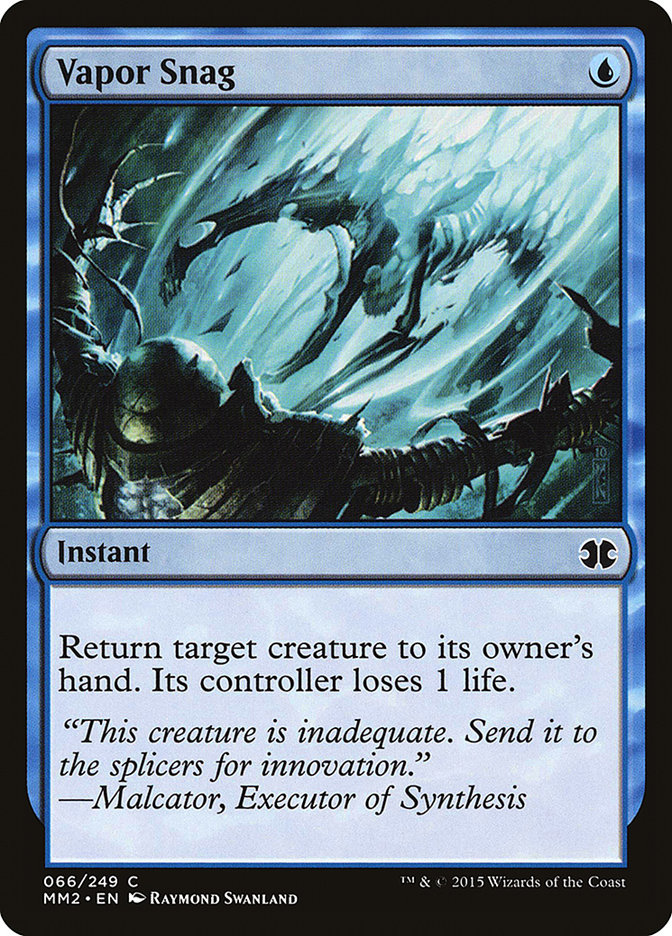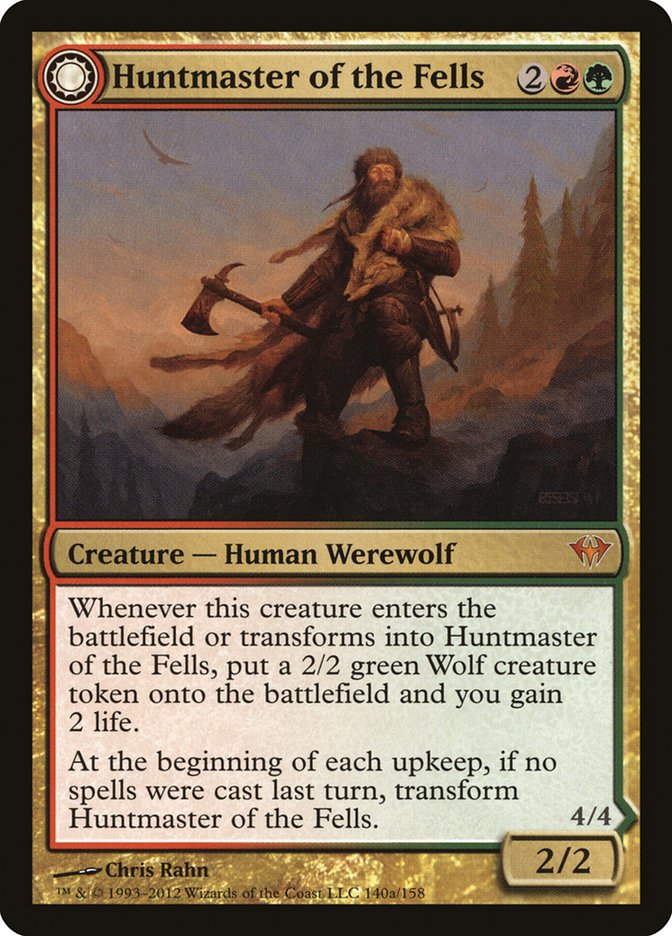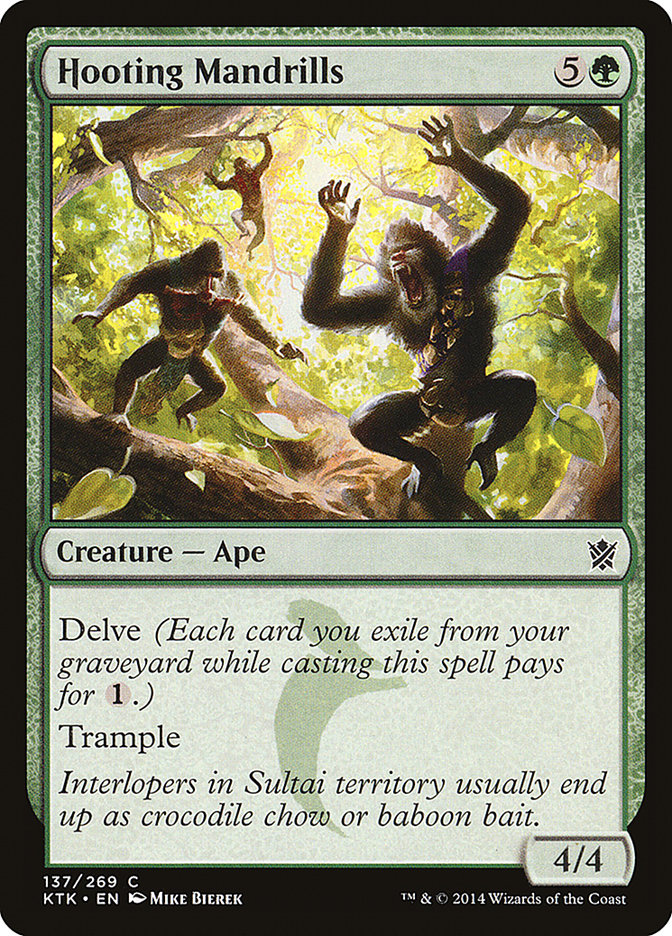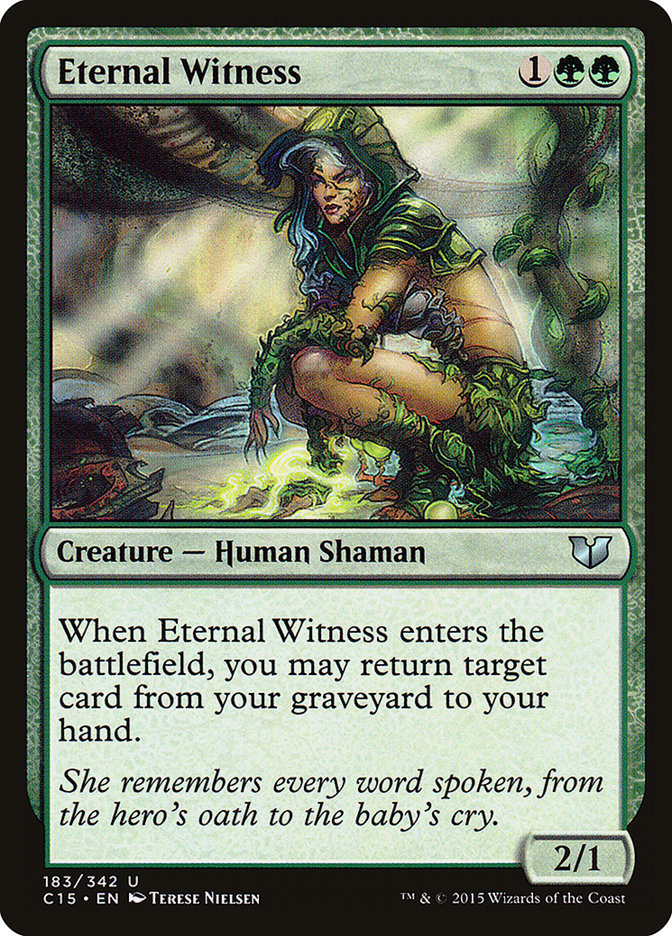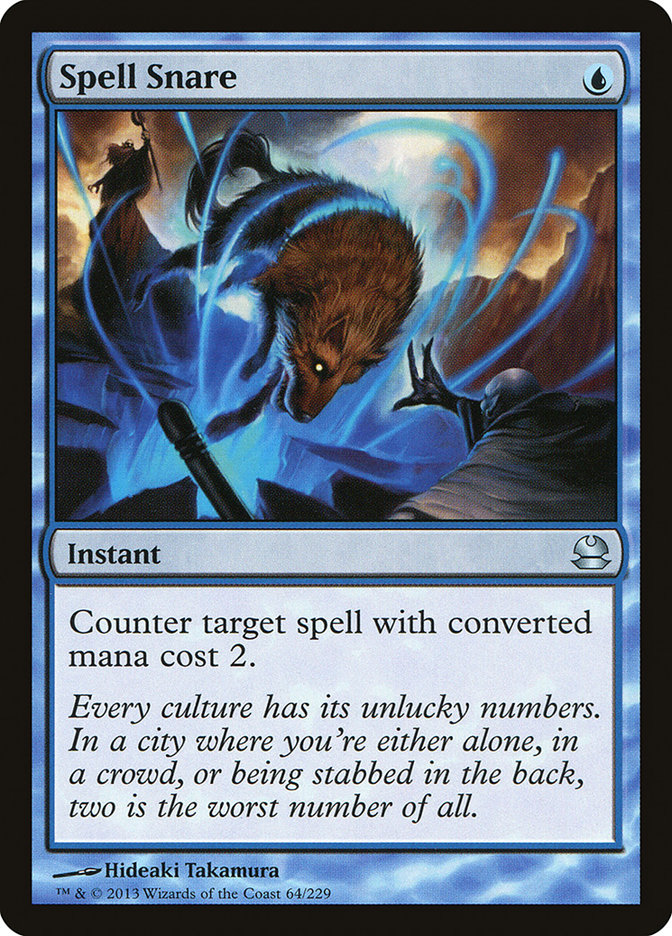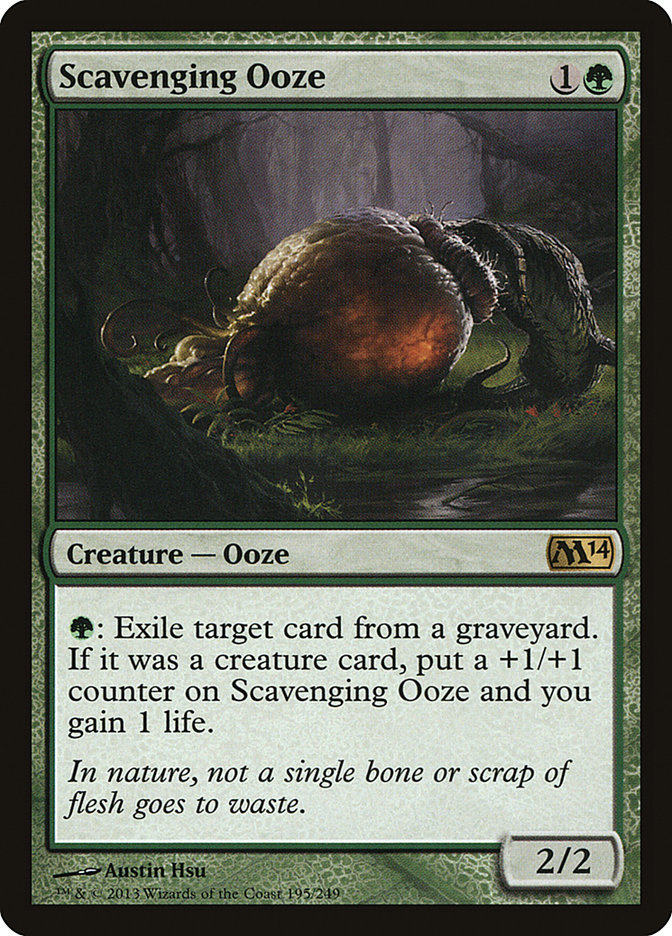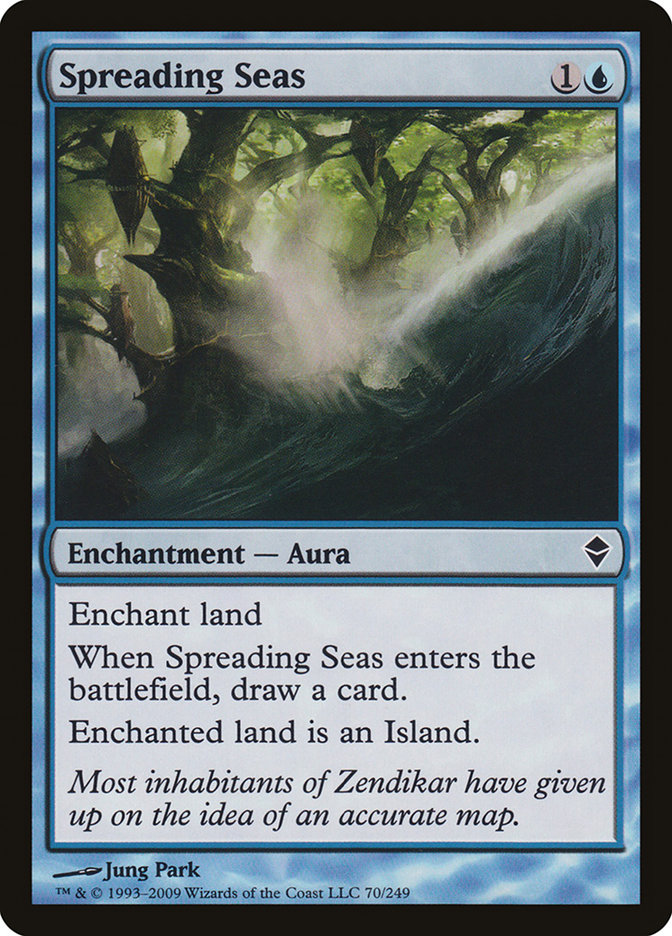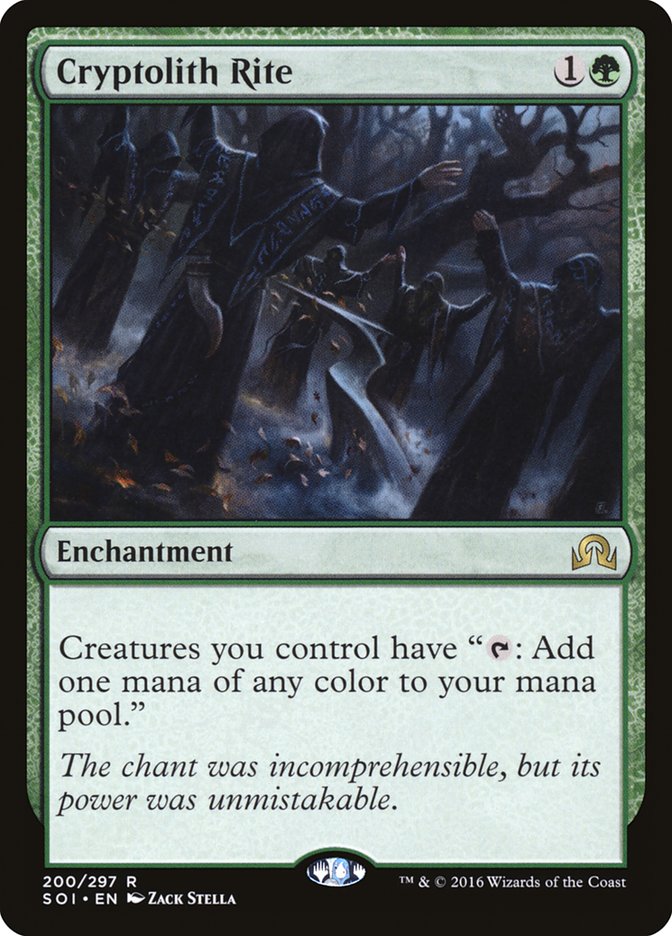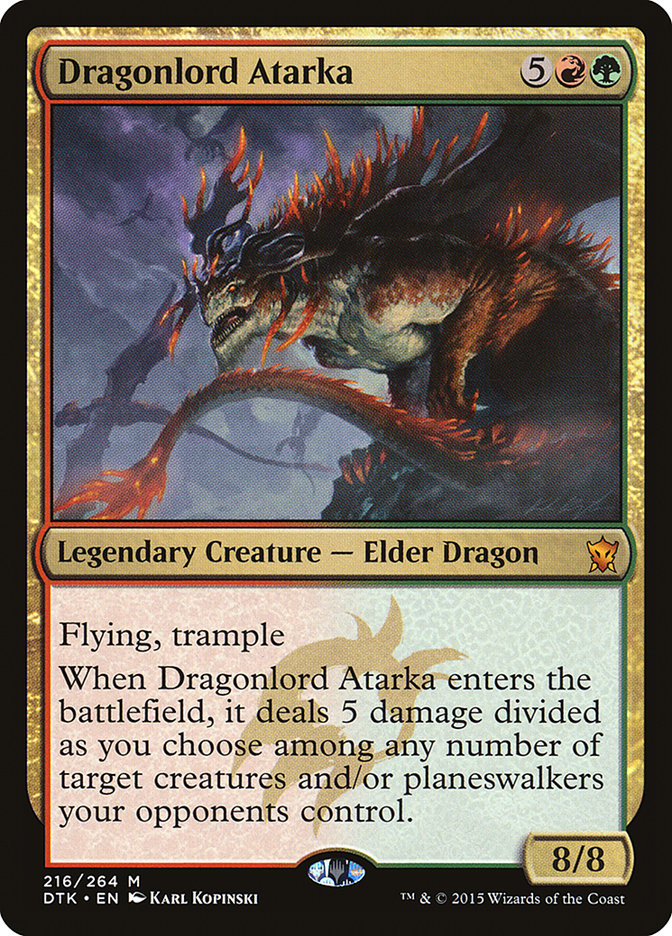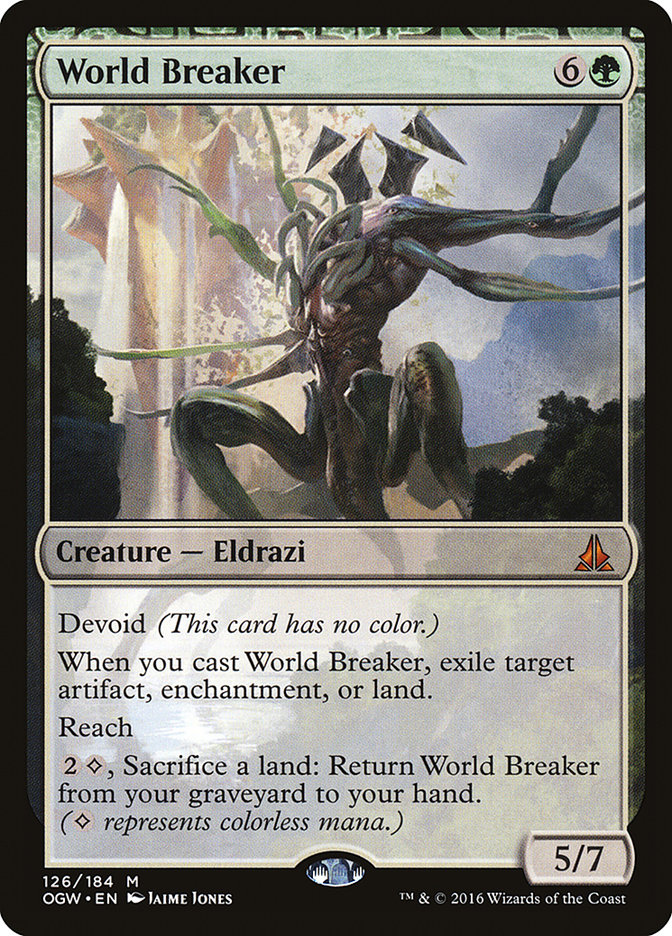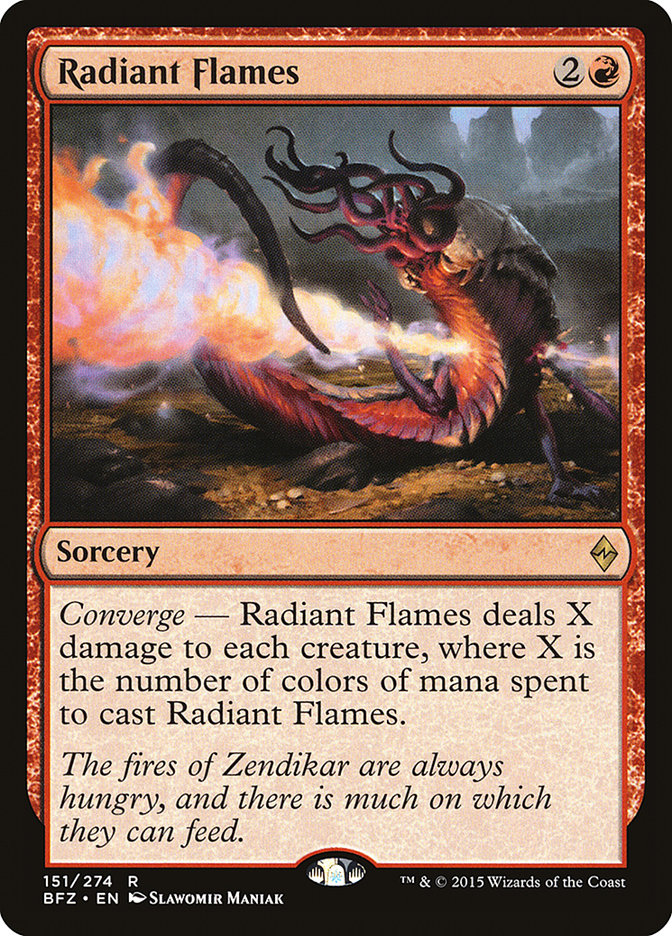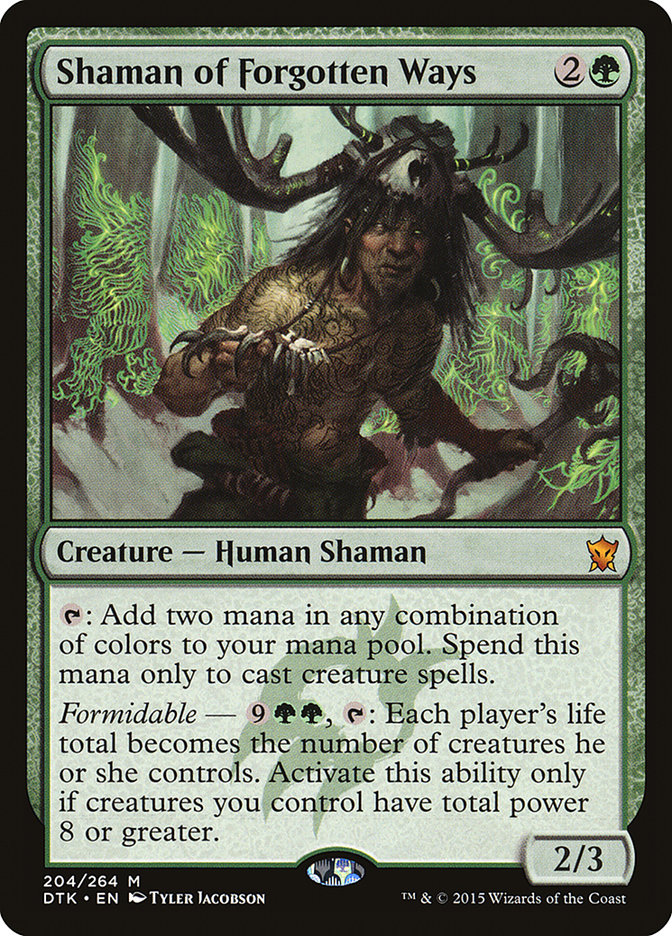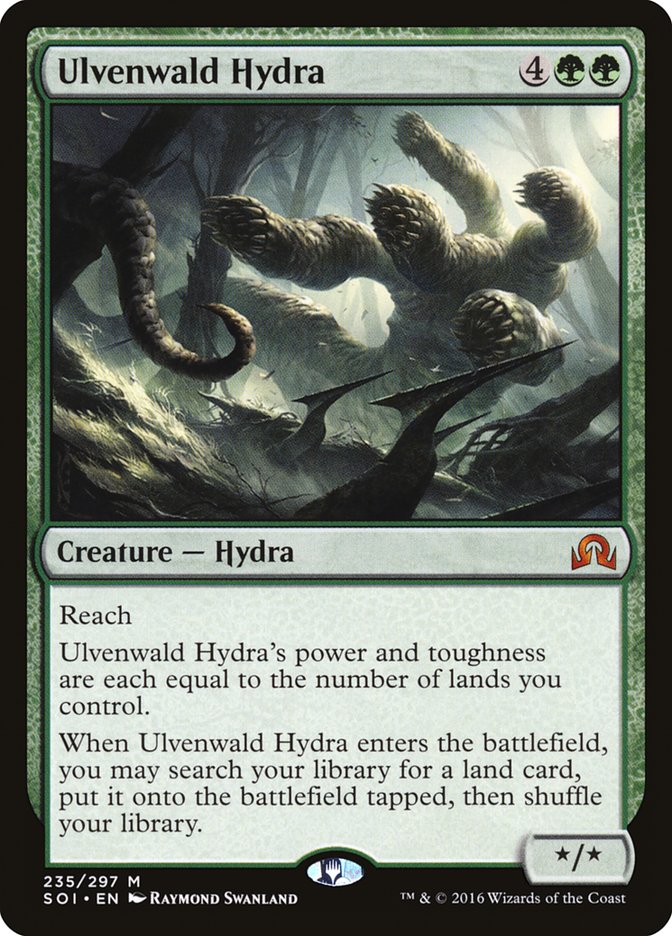
Creatures (13)
- 4 Tarmogoyf
- 1 Vendilion Clique
- 1 Scavenging Ooze
- 4 Snapcaster Mage
- 1 Young Pyromancer
- 2 Hooting Mandrills
Lands (22)
Spells (25)

Now, while I didn’t do all that well overall, I did start off 7-0 (5-0 after two byes), and the deck felt like it was running smoothly. The next three didn’t go according to plan, but honestly I feel like I was only a few cards away from something actually good. There is a strong chance I could have been 10-0 after those rounds, but I couldn’t draw a land here or didn’t play the tightest I could there, and suddenly the house of cards comes crumbling down.
Perhaps a more aggressive version featuring Delver of Secrets and more copies of Vapor Snag would have made things run a bit more smoothly. Delver isn’t a great card in Modern, but it does put a lot of pressure on removal from your opponents, making it more likely your Tarmogoyfs and Hooting Mandrills get the job done. It is also phenomenal against combo decks, since you’re able to drop a threat on the first turn and can hold up Remand or other counterspells for the next few turns.
This version was trying to be a bit more midrange, and I considered trying out Ancestral Vision, but it doesn’t work all that well with Hooting Mandrills. If I want to play Mandrills (which I do), then I would prefer more cards like Thought Scour to enable delve. I’ve seen versions that feature Huntmaster of the Fells and Ancestral Vision, which I do like in theory, but I feel they’re both a little too slow in the current format.
I would also like to try out Traverse the Ulvenwald, but I don’t know if it is worth it. A toolbox featuring stuff like Eternal Witness; Thrun, the Last Troll; and a host of other creatures would make the deck a lot less consistent. I also don’t want more virtual copies of stuff like Young Pyromancer, since we don’t have Treasure Cruise or other bursts of card draw.
In order to play stuff like Cryptic Command, I ended up playing 22 lands, which was great at some points, but I think I’d rather just play fewer lands and a few more spells. Cryptic Command is a fine card, but I don’t think that is the direction the deck wants to go. I know that probably means playing Delver of Secrets, but it is possible to build a tempo deck without that card. I just don’t think we have access to a more inherently powerful one-drop creature, and the way Delver of Secrets can shape a game is nice when we’re relying on soft counters like Spell Pierce and Remand.
Spell Snare was solid at helping to fight Tarmogoyfs and the like, but I honestly think Spell Pierce would have served me better. Too often was I stuck with Spell Snare against decks without a lot of two-mana spells, and in many situations I would have won games with Pierce in my hand over Snare. It is hard to tell when one is better than the other, and the rest of the deck matters. I would likely play Spell Snare again over Spell Pierce, given a similar decklist, but Delver of Secrets decks definitely want to be playing Spell Pierce.
The sideboard should have had a few more removal spells in it, and probably another Dispel. Having access to a cheap removal spell like Gut Shot could have potentially won me a match against Infect, and I’m wary of playing so few removal spells after sideboard moving forward. Gut Shot solves a lot of problems that can arise in a deck like this, and I’m always happy to play more free spells with Snapcaster Mage.
Scavenging Ooze was mediocre, so I would likely cut both of them in the future. The removal spell suite in the maindeck was fine, and all of them showed up at just the right time at least once. Vapor Snag was used primarily on my own creatures to protect them from removal, which likely means it’s versatile enough to play more copies. I’ve always loved Vapor Snag alongside Snapcaster Mage, and you don’t need to give me too many reasons to play more of them.
I’m not sure if there is enough reason to play graveyard hate like Surgical Extraction in the sideboard, though it is particularly great against the Grishoalbrand deck. Unfortunately, it doesn’t do much against opposing Snapcaster Mage or Tarmogoyf decks and we can’t afford to play something like Relic of Progenitus or Grafdigger’s Cage, so that probably means we shouldn’t bother.
Spreading Seas was great, as usual. I think it is important to know when your deck wants either Spreading Seas or Blood Moon, or potentially some other form of land destruction to help keep G/R Tron in check. While Spreading Seas doesn’t help much against stuff like Scapeshift, it is serviceable in a number of other matchups. Burn decks have a tough time using the blue mana from Spreading Seas, making it effectively Stone Rain plus a draw. It can also aggressively attack Inkmoth Nexus or green sources from Infect, keeping them from killing you out of nowhere. At this point, if you’re going lower to the ground and don’t want to mutilate your manabase, Spreading Seas is getting the nod over Blood Moon.
If you are interested in what the updated Delver list would look like, I might start here.
Creatures (15)
Lands (19)
Spells (26)
- 4 Lightning Bolt
- 4 Serum Visions
- 4 Remand
- 3 Spell Pierce
- 1 Flame Slash
- 1 Forked Bolt
- 4 Gitaxian Probe
- 3 Vapor Snag
- 1 Thought Scour
- 1 Izzet Charm
Sideboard

Of course, this list is infinitely customizable, which is the main draw of my Temur Box to begin with. Some small changes could be made here and there to “fix” certain matchups, though honestly it is pretty rare that you’re able to handle everything the format can throw at you. That’s the biggest hurdle in Modern, and likely the biggest selling point. Many decks are viable, but it takes a little luck and a lot of preparation to take down a tournament.
Without access to Splinter Twin anymore, playing a Temur deck is likely a tough sell. You always had the backup plan of Splinter Twin against the range of Modern decks, making sure you had outs to beat most anything. As of now, you’ll have to guess the metagame spot-on if you want to succeed with this type of strategy.
Gettin’ Big in Standard
I think the time has come for me to move on from Pyromancer’s Goggles in Standard. I do think the card is good, but having your deck revolve around an engine is tough when there are a number of ways to interact with said engine. Grixis Control feels like a nightmare since Kolaghan’s Command is so brutal. Also, counterspells. U/R Goggles could be supplanted by G/R Goggles Ramp permanently, though neither is great at beating Gideon, Ally of Zendikar. In the early weeks of Standard, Gideon wasn’t hugely popular, but that time has passed.
At the moment, Standard is flooded with token strategies that are resilient to spot removal but pretty weak to sweeper effects. Grixis Control featuring Radiant Flames in the maindeck could be a great option, as many of the Cryptolith Rite decks are also weak to Kalitas, Traitor of Ghet. If I were to play a control deck at the moment, it would likely be playing a lot of copies of both.
The trick is figuring out the manabase, as well as the rest of the utility spells. I’m not a huge fan of counterspells at the moment, though they shine against the planeswalker-heavy decks and are likely necessary if you want to have a shot at winning the first game. Even if you have something like Ruinous Path to take down a Gideon, the remaining token (or emblem) is sure to be problematic.
On the other side of the coin, if you want to beat up on Cryptolith Rite and Gideon decks, you could just go bigger. Many people are starting to figure out that you can beat these decks if you have a plan that involves going way over the top of them. Ramping into Ulamog, the Ceaseless Hunger or even Dragonlord Atarka is usually enough to get the job done. Even if they’re able to get rid of it, as long as you have other stuff going on, the lasting effect of killing their best card(s) is huge.
While you have the option to play creature-based ramp, spell-based ramp, or land-based ramp (Mage-Ring Network), I’m currently in the camp of jamming some big baddies with the help of Shaman of Forgotten Ways.
Creatures (24)
- 2 Shaman of Forgotten Ways
- 3 Dragonlord Atarka
- 2 Ulamog, the Ceaseless Hunger
- 2 Sylvan Advocate
- 4 Deathcap Cultivator
- 3 Tireless Tracker
- 4 Ulvenwald Hydra
- 4 Duskwatch Recruiter
Lands (24)
Spells (12)

There is certainly a lot going on here, but the main takeaway for me is that Justin felt like playing “All Ramp, All the Time” was the way to go. No bells or whistles, just ways to gain an insane mana advantage and then use that mana to play gigantic monsters. In a lot of ways, this deck feels like G/R Devotion, as you have a few small creatures that take advantage of having access to a lot of mana, but you can also present threats and pressure against slower strategies. Tireless Tracker and Duskwatch Recruiter have proven useful in a number of strategies, but I can only imagine they get better when your overall plan is to get as much mana as possible.
And like those green devotion decks, we have a lot of top-end. Dragonlord Atarka and Ulamog, the Ceaseless Hunger are obviously nuts if you can cast them, and the entire goal of this deck is to get a big mana advantage and then use either Oath of Nissa or Duskwatch Recruiter to find them.
Of course, you aren’t a true spell-ramp deck, but you do have both Nissa’s Pilgrimage and Explosive Vegetation at your disposal. The kicker is that we aren’t trying to get cute with Chandra, Flamecaller or Kozilek’s Return. On top of that, World Breaker is pretty pathetic without the Flashback on Kozilek’s Return, and moving more towards Dragonlord Atarka and Ulamog is solid.
But this deck does have its weaknesses. Aggressive decks can run you over pretty easily, and we don’t really have a way to stop it. Radiant Flames out of the sideboard is nice and all, but unlikely to be enough. Cheap removal spells, discard, or counters from control can slow the deck down significantly, but those decks tend to have a lot of trouble dealing with Ulamog, so there is a bit of give and take. If you draw the half of your deck that plays Nissa’s Pilgrimage and ramps without the creatures, they’re going to have a tough time beating your top-end. This is especially true when Dragonlord Atarka is killing their planeswalker when it enters the battlefield.
The trick here is that we’re making ramp impervious to flooding out, much like all of the other decks in Standard. Clue tokens from Tireless Tracker and digging for creatures with Duskwatch Recruiter mean you’re rarely going to have turns where you can’t spend all of your mana. Oath of Nissa on top of all this makes the deck consistent on top of fast and powerful.
I’m a huge fan of this archetype at the moment, and we haven’t had too many Standard events in the last few weeks to see what this type of deck can do. The cool thing here is that this is just the tip of the iceberg. With Evolving Wilds, Shaman of Forgotten Ways, and Explosive Vegetation, we have the option to branch out into other colors if we really want to. Dragonlord Silumgar seems pretty well-positioned at the moment, though Dragonlord Atarka is likely the better option for this green-based deck.
Standard is in a very strange place. Midrange decks rule the roost, and the best of those have plans to help fend off aggro and can produce enough resources to play a super-late game. Our job is to find a way over, under, or through those decks.
Bant Company, G/W Tokens, and Cryptolith Rite make it a nightmare to attack on the ground, so let’s get in the air a bit. Or make our creatures unblockable via Rogue’s Passage. Ulvenwald Hydra is criminally underrated at the moment, and I’m hoping that someone puts an upcoming tournament through the wringer with it. Having access to Rogue’s Passage in this format is ridiculously strong. On top of that, a single Mirrorpool can also shift the tide against an attrition-heavy deck. Momma always said that the second one is never as good as the first, but I’m saying it’s close enough.
A Word About Magic and Technology
I was going use my article this week as a soap box, outlining all of my current frustrations with Magic. Their shoddy tournament software caused huge disruptions at Grand Prix Charlotte, Magic Online continues to disappoint me, and I have a nagging sense we’re getting left behind by the rest of the gaming world. But in the grand scheme of things, complaining about this stuff isn’t going to change anything. Do you honestly believe that the people who work on Magic Online don’t know how bad it is?
We’ve gotten to the point where the only options are to accept these things, knowing that they’re probably never going to be fixed or that they’re taking way too long, or to quit. And since Magic is such a big part of my life, I suppose the former option is the only one I can do right now. Maybe that will change in the future. Maybe it won’t. But instead of beating a dead horse, I’m going to devote more of my mental energy to the things I can control.


